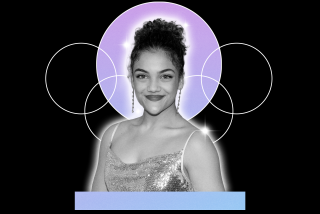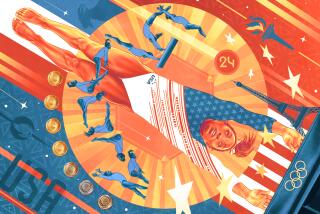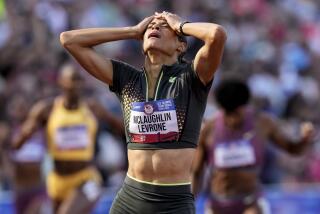Biggest Leap Was Finding Each Other : Track and field: Sheila Hudson, Kenny Harrison have more in common than the triple jump.
- Share via
BERKELEY — Sheila Hudson, U.S. record-holder in the women’s triple jump, sprinted toward the pit at Cal’s Edwards Stadium. She took off on her left foot and, ultimately, landed more than 40-feet away.
It looked like a perfect jump.
But Kenny Harrison, observing nearby, detected flaws.
“Sheila, you took off too soon,” Harrison said as he analyzed her jump.
Harrison critiqued Hudson’s two other jumps before she took a break.
Then it was Harrison’s turn.
Harrison, who has the second-best triple jump mark in the world this year, 57 feet 3 1/2 inches, did a few practice jumps and Hudson critiqued him.
“It works great, until we get mad at each other,” Harrison joked. “If she’s out here and she sees frustration on my face she can identify with it and clear it up fast. If I was working with a coach they might get their head snapped off.”
Hudson and Harrison are more than training partners, however. They have been going together for the last three years.
Loving relationships aren’t unusual in track. The husband-wife team of David and Sandra Patrick is made up of two world-class hurdlers, and Jackie Joyner-Kersee is coached by her husband Bob. And of course there are Al Joyner and wife Florence Griffith Joyner.
Both Hudson and Harrison appear to have benefited athletically from their relationship.
Hudson, who just graduated from California, set an American indoor record of 45 feet 9 inches at the NCAA championship meet last March. She also won the NCAA indoor long jump title with a personal-best leap of 21-9.
Two weeks ago, she set an American outdoor triple jump record of 46- 3/4 at the NCAA meet. She also won the NCAA long jump title with a personal-best 22-1, beating runner-up Dana Boone of Virginia by almost 1 1/2 feet.
Harrison, a former Kansas State star, jumped 57-3 indoors this year, the best triple jump by an American and the second best jump in the world this season.
Both Hudson and Harrison will compete in the USA-Mobil national championship meet beginning Tuesday at Cerritos College in Norwalk.
Harrison and Hudson met on a triple jump runway. No kidding.
Harrison first saw Hudson at the 1986 NCAA outdoor meet, as he was warming up.
“I saw her running and she was an impressive runner to me for a women because she didn’t run with that certain thing that women run with,” Harrison said. It was a nice powerful run and I really liked that.”
What did Hudson like about Harrison?
“Even though he didn’t come out on top all the time, I knew he was going to make it,” Hudson said.
Harrison wrote to Hudson, who was attending California. After corresponding for a year, they got together at the 1987 Modesto Invitational.
They discovered they had a lot in common.
“He sent me a picture of his house, and our houses are identical,” Hudson said. “They have the same furniture and the same floor plan.”
Said Harrison: “I came to her house for the first time and I said ‘This is my house. That’s my furniture and this is our family room.’ It was scary.”
Another similarity: Hudson, 5-feet-4 and 115 pounds, and Harrison, 5-9 and 165, were both star point guards on their high school basketball teams.
Harrison is 25, Hudson 22.
After graduating from Kansas State in 1987, Harrison moved to Berkeley to train with Hudson.
“Now that we’re training together, we go in the weight room and look in the mirror and we notice that our bodies start looking the same,” Hudson said. “We have the same muscle tone.”
Do they take the sport home with them?
“We talk about it enough that we don’t need to talk about it away from the track,” she said.
Hudson, who had four coaches in five years at Cal, flourished after she began working with Harrison.
“It’s important to have some kind of continuity in your workouts,” she said. “I couldn’t take the changes anymore. I’d take a little bit from everybody and make up my own workouts.
Although it seems as simple as a hop, skip and a jump, the triple jump is really a complex event.
“It takes years to get used to because it’s an awkward event,” Hudson said. “There’s a lot to every phase, the hop phase and the jump phase. And you have to be patient to learn to apply everything.
The first portion is the hop. After sprinting down the runway, the jumper takes off on either foot and lands again, 17-18 feet away, on that same foot, moving immediately into the transition or skip phase. The jumper bounces off on the landing foot and drives the body forward, landing again on the opposite foot and pushing off into the jump phase, finally landing on either leg or both.
It’s harder than it sounds, which is why many long jumpers who have taken up triple jumping aren’t successful.
“It’s so difficult because in the long jump you only have to learn the first phase,” Harrison said. “Once you do the takeoff, your job is done. You could land in a ball. It doesn’t make any difference.”
Although Hudson is also a long jumper, she prefers the triple jump.
Why?
“(The long jump is) boring to me,” she said. “In the triple jump, you have to take off and get prepared for the most tremendous shock you’ve ever had. And then you take off again and find your center of gravity and prepare for another one of those jolts and try and get as much distance as you possibly can.
“During that, you’re fighting the speed you’ve created on the runway. And you have to be such a patient and a mentally strong person to do it.”
A prep star from Brookfield, Wis., Harrison burst into national prominence after setting a national mark of 52 feet in the triple jump at a postseason prep invitational meet in 1983. Although he was contacted by several big-name track schools, he chose Kansas State, which had recruited him from the start.
Hudson, a sprinter at Rio Linda High school near Sacramento, became a triple jumper by accident.
“I have a good story and I have the real story of how I started jumping,” Hudson said. “I normally say I started triple jumping because it was such a different event, because it was fun from the very beginning and it was another chance and jump and get dirty in the sand.”
The real story?
She began triple jumping to show up a rival on her high school team.
“I saw her triple jumping one day and I just had to go over and beat her,” Hudson said. “We weren’t very good friends at the time, but I guess I should call her and thank her because if it wasn’t for her, I wouldn’t have become a triple jumper.”
But Hudson has had to become a proficient long jumper because the women’s triple jump isn’t currently contested in the Olympics and won’t be until the 1996 Summer Games.
Hudson dreamed of making the 1988 Olympics.
Her mother is a Korean who married a black American soldier and Hudson dreamed of going to Seoul for the 1988 Games.
Hudson thought she had a good shot at making the team as a long jumper.
“I was confident going in because I was jumping well,” she said.
But she bombed in the trials, fouling on all three of her jumps.
Heartbroken, Hudson didn’t watch the Olympics because she said it was too painful. But the setback made her more determined to make the 1992 Olympic team.
Harrison just missed making the 1984 and 1988 Olympic teams.
A prep phenom in the triple jump, Harrison was 19 and a year out of high school when he competed in the 1984 Olympic trials and he was in awe of the other competitors such as Willie Banks, American record holder.
“I got on the runway and (Banks) told me to get out of the way,” Harrison said. “And I got out out of the way.”
Banks jumped 59-8 to make the 1984 Olympic team, but Harrison didn’t make the team.
Then, undefeated going into the 1988 Olympic trials, Harrison finished sixth, again failing to make the team.
After that, Harrison didn’t enter a meet for nine months, concentrating on his training. He is undefeated since returning to competition and plans to try out for the ’92 Olympic team.
More to Read
Go beyond the scoreboard
Get the latest on L.A.'s teams in the daily Sports Report newsletter.
You may occasionally receive promotional content from the Los Angeles Times.










